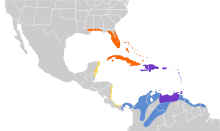Gray kingbird
The gray kingbird or grey kingbird, also known as pitirre, petchary, or white-breasted kingbird (Tyrannus dominicensis) is a passerine bird.
| Gray kingbird | |
|---|---|
.jpg) | |
| T. d. vorax, Tobago | |
| Scientific classification | |
| Kingdom: | Animalia |
| Phylum: | Chordata |
| Class: | Aves |
| Order: | Passeriformes |
| Family: | Tyrannidae |
| Genus: | Tyrannus |
| Species: | T. dominicensis |
| Binomial name | |
| Tyrannus dominicensis (Gmelin, 1788) | |
 | |
Habitat
This tyrant flycatcher is found in tall trees and shrubs, including the edges of savanna and marshes. It makes a flimsy cup nest in a tree. The female incubates the typical clutch of two cream eggs, which are marked with reddish brown.
Description
The adult gray kingbird is an average-sized kingbird. It measures 23 cm (9.1 in) in length and weighs from 37 to 52 g (1.3 to 1.8 oz).[2] The upperparts are gray, with brownish wings and tail, and the underparts are white with a gray tinge to the chest. The head has a concealed yellow crown stripe, and a dusky mask through the eyes. The dark bill is heavier than that of the related, slightly smaller, tropical kingbird. The sexes are similar, but young birds have rufous edges on the wing coverts, rump and tail.
Call
The call is a loud rolling trill, pipiri pipiri, which is the reason behind many of its local names, like pestigre or pitirre, in the Spanish-speaking Greater Antilles, or petchary in some of the English-speaking zones.
Diet and behaviour
Gray kingbirds wait on an exposed perch high in a tree, occasionally sallying out to feed on insects, their staple diet.
Like other kingbirds, these birds aggressively defend their territory against intruders, including mammals and much larger birds such as caracaras, red-tailed hawks and broad-winged hawks.
Distribution & range
It is found in increasing numbers in the state of Florida, and is more often found inland though it had been previously restricted to the coast. The species was first described on the island of Hispaniola, then called Santo Domingo, thus the dominicensis name. It breeds from the extreme southeast of the United States, mainly in Florida, through Central America, from Cuba to Puerto Rico as well as eastward towards all across the Lesser West Indies, south to Venezuela, Trinidad, Tobago, the Guiana, and Colombia. Northern populations are migratory, wintering on the Caribbean coast of Central America and northern South America. Several vagrant populations are known to exist in the American Northeast.
Gallery
References
- BirdLife International (2012). "Tyrannus dominicensis". IUCN Red List of Threatened Species. 2012. Retrieved 26 November 2013.CS1 maint: ref=harv (link)
- Dunning, John B., Jr. (ed.) (1992). CRC Handbook of Avian Body Masses. CRC Press. ISBN 978-0-8493-4258-5.
- Hilty, Steven L (2003). Birds of Venezuela. London: Christopher Helm. ISBN 0-7136-6418-5.
- ffrench, Richard (1991). A Guide to the Birds of Trinidad and Tobago (2nd ed.). Comstock Publishing. ISBN 0-8014-9792-2.
External links
| Wikimedia Commons has media related to the gray kingbird. |
- Videos, photos & sounds on the Internet Bird Collection
- Bird sounds - Florida Museum of Natural History



.jpg)